The rapid ascent of the 6.5 Creedmoor in recent years has ignited the 6.5 Creedmoor vs 308 debate among hunters. Here’s what you need to know about these two cartridges.
I think most shooters agree that the .308 Winchester and 6.5 Creedmoor are both fantastic cartridges for competition shooting. While the .308 Winchester has been around for a long time and also has a well deserved reputation as an effective cartridge for hunting a variety of game, many hunters are skeptical of the capabilities of the comparatively new 6.5 Creedmoor as a hunting cartridge. So what’s the real deal with hunting with the 6.5 Creedmoor vs 308 Winchester?
Unfortunately, there is a lot of marketing hype as well as a few genuine misunderstandings regarding the capabilities of the 6.5 Creedmoor that complicate this discussion. For that reason, it’s easy to understand how many hunters get confused about the strengths and weaknesses of the 6.5 Creedmoor and the .308 Winchester as hunting cartridges.
In this article, I’m going to discuss the pros and cons of the 6.5 Creedmoor vs 308 Winchester so you can make an informed decision on which one is right for your particular situation.
Table of Contents
Before we get started, I have two administrative notes:
Some of the links below are affiliate links. This means I will earn a small commission (at no extra cost to you) if you make a purchase. This helps support the blog and allows me to continue to create free content that’s useful to hunters like yourself. Thanks for your support.
Additionally, I recorded an entire podcast episode on this exact subject. If you’d rather listen than read, click the appropriate link below to listen to this episode on your preferred podcasting player.
Be sure to hit that “Subscribe” button in your podcast player!
6.5 Creedmoor vs 308 Podcast
Apple | Google | iHeart | Pandora | Spotify
6.5 Creedmoor vs 308: History
First, I recorded an entire video episode on this exact subject. If you’d rather listen or watch than read, watch the YouTube video below.
The story of the .308 Winchester begins right after World War II when American military leaders decided to replace the venerable .30-06 Springfield cartridge and M-1 Garand rifle. Though the cartridge and rifle performed admirably in the hands of American GIs, military leaders wanted a new rifle with a detachable magazine that was capable of fully automatic fire similar to the Soviet AK-47 or the German StG-44.
The Germans kicked off this trend by replacing bolt-action rifles chambered in 7.92x57mm Mauser cartridge with the automatic StG-44 chambered in the much shorter 7.92×33 Kurtz round in the middle of the war for some of their elite units. The Soviets followed down a similar path a few years later with the 7.62x39mm cartridge taking the place of the 7.62x54R round in their primary infantry service rifle.
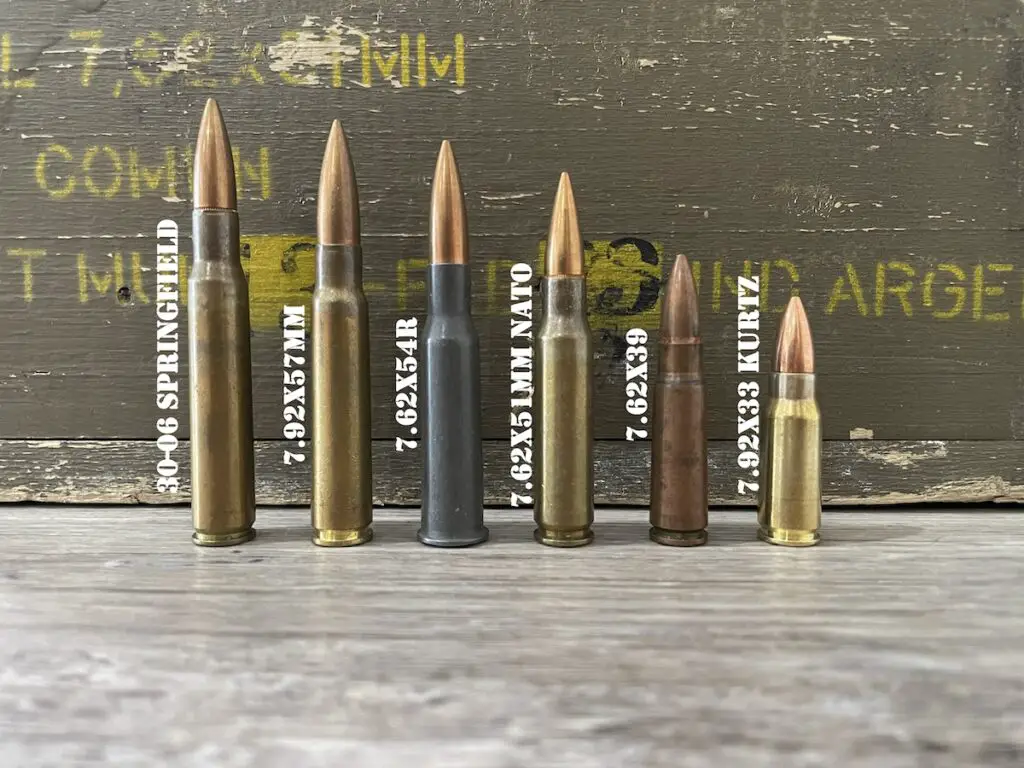
After several years of development and testing, the US Army replaced the M-1 Garand with the M-14 rifle chambered in the new 7.62x51mm cartridge. Like the .30-06, the new cartridge also fired a .308″ bullet. However, due to advances in powder technology since the introduction of the .30-06, the 7.62x51mm cartridge used a shorter case (51mm vs 63mm), but had virtually the same ballistics (a 147 gr bullet at 2,750 fps vs a 150 gr bullet at 2,700 fps) as the .30-06.
If you’d like to read a more detailed discussion on the 7.62x51mm cartridge and how it compares to the .30-06 Springfield, read this article:
308 vs 30-06 vs 300 Win Mag: Which Cartridge Should You Be Hunting With?
Around that same time, the leadership at Winchester saw a lot of potential for commercial success in the civilian hunting and shooting markets with the new 7.62x51mm cartridge and rolled out the extremely similar .308 Winchester. In short, though modern 30-06 ammunition can fire the same weight bullet 100-200fps faster, the .308 Winchester could do almost everything the .30-06 Springfield could do with up to a 180 grain bullet.
Plus, the new cartridge could fit in a short action rifle and had a slight edge in accuracy over the .30-06.
As a result, the popularity of the new .308 Winchester cartridge gradually increased as hunters and shooters realized the inherent accuracy, efficiency, and power of the cartridge.
For these reasons, the .308 Winchester was one of the most popular short-action rifle cartridges for many decades and eventually became the standard against which other short-action cartridges were judged. Many of the other popular short-action cartridges (like the .243 Winchester, .260 Remington, and 7mm-08 Remington) were descended from the .308 Winchester.
The .308 Winchester was a very popular cartridge for high power rifle competition shooting for many years. However, Dave Emary of Hornady Manufacturing saw an opportunity to build a new cartridge that outperformed the .308 Winchester in the early 2000s in response to some frustrations Dennis DeMille of Creedmoor Sports had been having with the 6 XC cartridge in shooting matches.
DeMille told Emary he wanted an off the shelf cartridge (in contrast to the 6XC he’d been struggling with that was a wildcat at the time) that was accurate enough to win a match, but also had less recoil, less wind drift, and a flatter trajectory than the 308 Winchester. And he said he wanted this new cartridge to have the loading recipe on the box label.
We need to quickly discuss another, not very well known, but very important centerfire rifle cartridge before moving onto the next chapter in this story: the 30 Thompson Center (or 30 T/C for short).
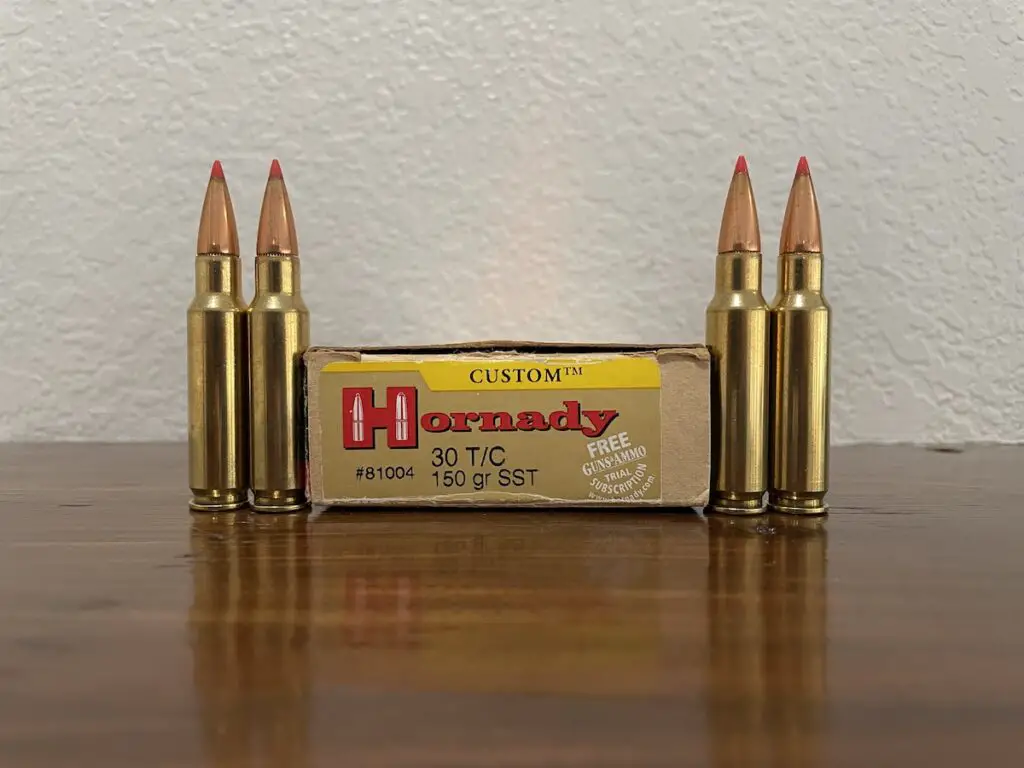
Designed by Hornady in partnership with Thompson Center for use in the T/C ICON rifle in 2007, the 30 T/C is a .30 caliber cartridge that delivers 30-06 level performance in a package smaller than the 308 Winchester.
Though similar in appearance to the 308 Winchester at first glance, the 30 T/C is different in a few key areas: it has a shorter case, it has less body taper, and it has a steeper 30 degree shoulder angle. Designers at Hornady also built the round with a chamber geometry that was highly conducive to outstanding accuracy (more on this later).
Hornady also released the 30 T/C in conjunction with their new “Superformance” line of powder. This new powder is one of the characteristics that allowed the smaller 30 T/C cartridge to actually match the 30-06 and exceed the 308 Winchester in terms of ballistic performance.
The end result was a short, fat, and efficient round that was compatible with very long ogive bullets and capable of fantastic accuracy.
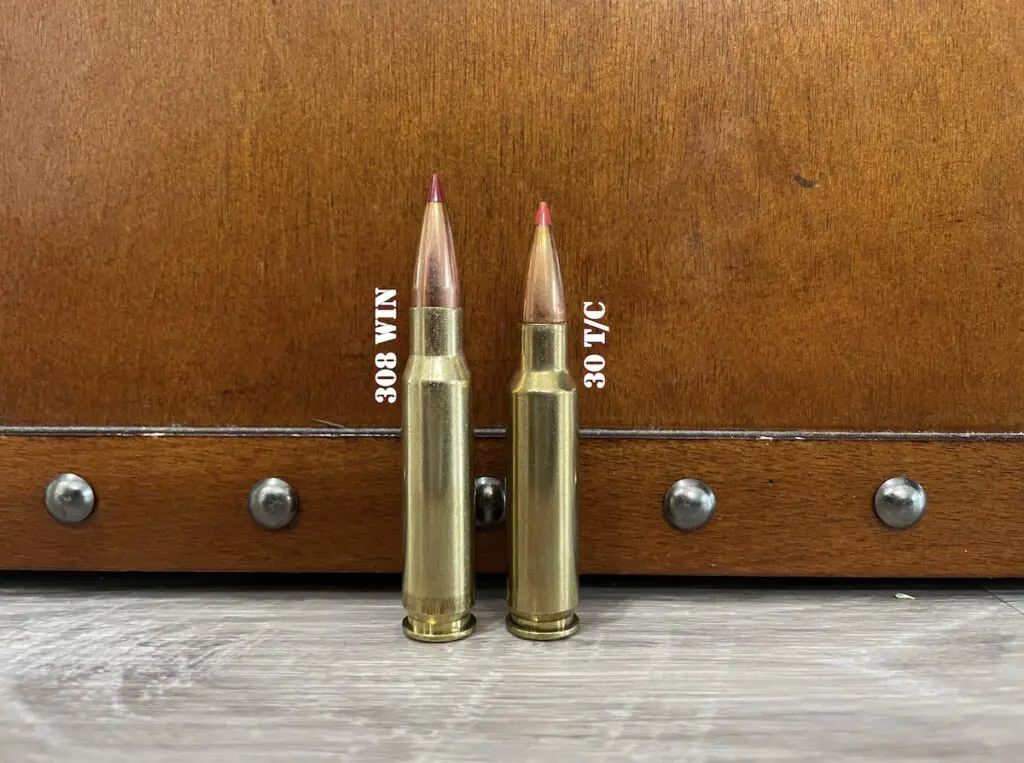
Those characteristics made the 30 T/C a great parent case for this new project for Dennis DeMille.
Next, Emary, Joe Thielen, and the rest of the Hornady design team decided to use 6.5mm projectiles in order to take advantage of the great balance that bore diameter provides in terms of low drag and good velocity potential without excessive recoil.
Furthermore, the short and fat 30 T/C case facilitated the use of very long, sleek, and aerodynamic 6.5mm bullets that would still fit in a short action rifle magazine without intruding into the powder column either. The 30 T/C cartridge also had a relatively large case capacity optimized for use with 4350 class propellants that deliver an excellent balance of accuracy and velocity.
So, they opted to neck down a 30 Thompson Center case to utilize 6.5mm or .264″ bullets. They also designed the chamber of the ensuing cartridge to incorporate some of the principles first utilized with the 30 T/C in terms in order to minimize Principle Axis Tilt and enhance accuracy overall.
With all this in mind, they specified that rifles chambered in this new round should utilize a relatively fast 1:8″ rifling twist rate in order to stabilize those long, high BC bullets.
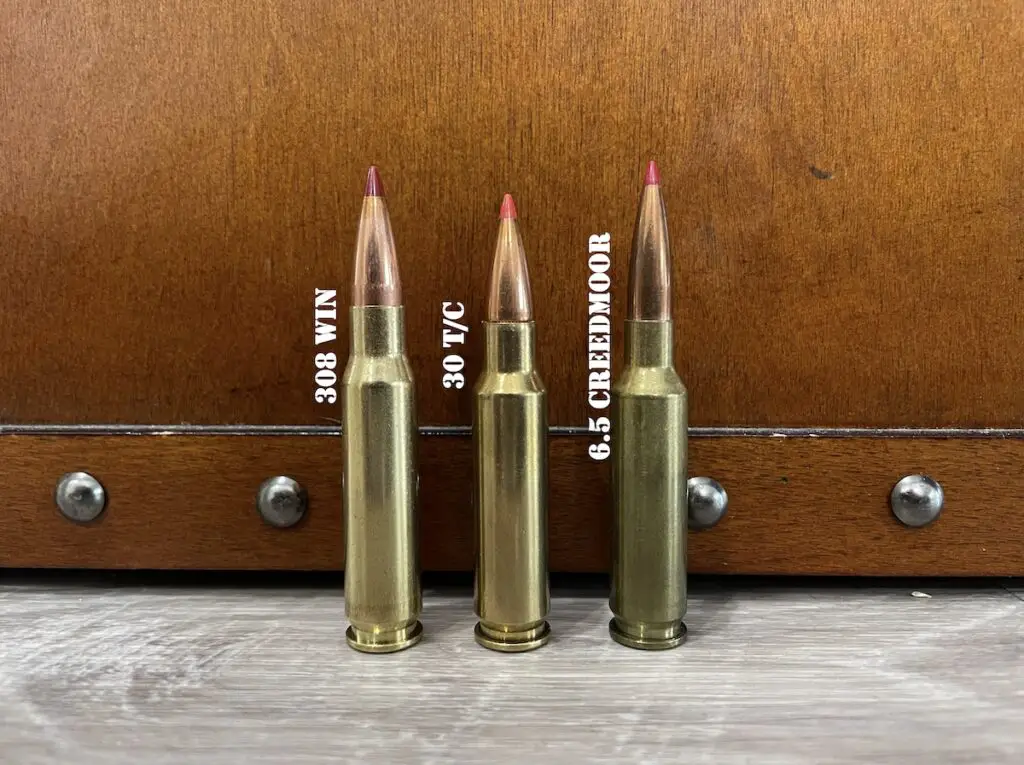
When all was said and done, Emary and the rest of the guys at Hornady were quite successful in their goal of building the ideal competition shooting cartridge in new round they dubbed the 6.5 Creedmoor.
Named in honor of the Creedmoor Matches and Creedmoor Sports where DeMille was the general manger at the time, the 6.5 Creedmoor (sometimes misspelled Creedmore) does not have eye popping ballistics, but it has minimal recoil, is very accurate, and uses high ballistic coefficient bullets that retain energy and resist wind drift exceptionally well.
For those reasons, the cartridge has seen a great deal of success in the hands of competition shooters and has recently made the jump into the mainstream hunting community.
6.5 Creedmoor vs 308: Cartridge Sizes
You can see some of the similarities and differences between the 6.5 Creedmoor and .308 Winchester cartridges in the photo below. Both cartridges are used in short action-rifles, so they have very similar external dimensions.
The .308 Winchester has a slightly longer same case length (1.92″ vs 2.015″), but the 6.5 Creedmoor has a little bit longer overall length (2.825″ vs 2.81″).
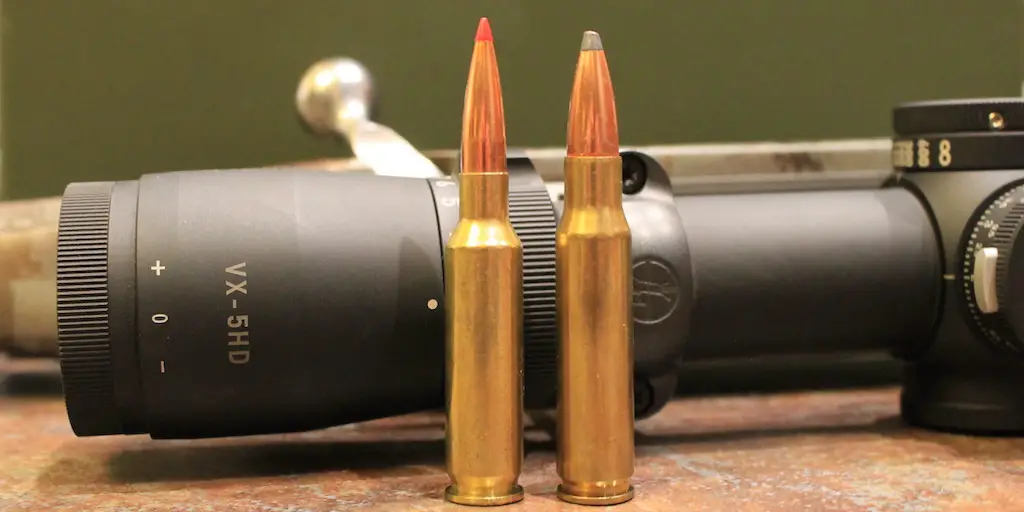
The 6.5 Creedmoor has a sharper shoulder angle (30 degrees vs 20 degrees for the 308) and a slightly less tapered case than the .308. Those traits allow the Creedmoor to use very long, high BC bullets without sacrificing case capacity.
Both cartridges have the same .473″ rim diameter, can hold almost the same amount of powder, and have the same SAAMI maximum average pressure of 62,000psi.
Note: while the case capacity figures listed below do give a good indication of the differences between the two cartridges, exact case capacities vary slightly according to the brand of brass used.
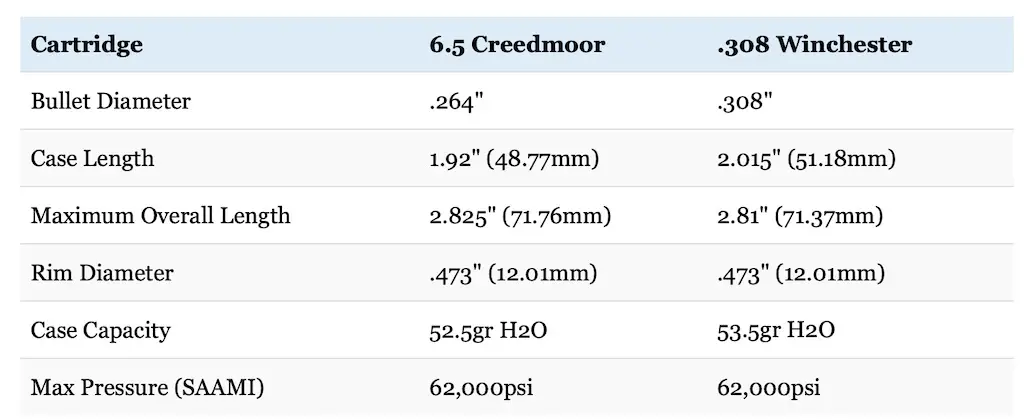
6.5 Creedmoor vs 308 Ballistics
The table below compares 120gr Ballistic Tip (.458 BC), 140gr Partition (.490 BC), and 143gr Hornady ELD-X (.625 BC) loads in 6.5 Creedmoor to 150gr Nosler Ballistic Tip (.435 BC), 165gr Partition (.410 BC), 180gr Partition (.474 BC), and 178gr Hornady ELD-X (.552 BC) loads in .308 Winchester.
The Ballistic Tip loads use light for caliber deer hunting bullets, the Partition loads use some of the heaviest for caliber bullets that are commonly available for each cartridge in factory loads, and the ELD-X loads use some of the highest BC bullets available for each cartridge.
Furthermore, the 308 is sometimes available with 180gr bullets, but not every manufacturer offers factory ammo with bullet weights that heavy and the cartridge will sometimes top out around 165/168gr. Nosler actually does not offer a 180gr Partition in a factory load for the 308 (Federal does though).
This is why I used both 165gr and 180gr loads from Nosler and Federal respectively in this comparison.
Before we go any farther comparing the ballistics of those cartridges, I want to direct your attention to the fact that the bullets used in those 6.5 Creedmoor loads all have a higher BC than those used in the comparable 308 Winchester loads (comparing Ballistic Tip to Ballistic Tip, ELD-X to ELD-X, etc.).
This data is for Federal, Hornady, and Nosler factory ammo using a 24 inch barrel and a 200 yard zero.
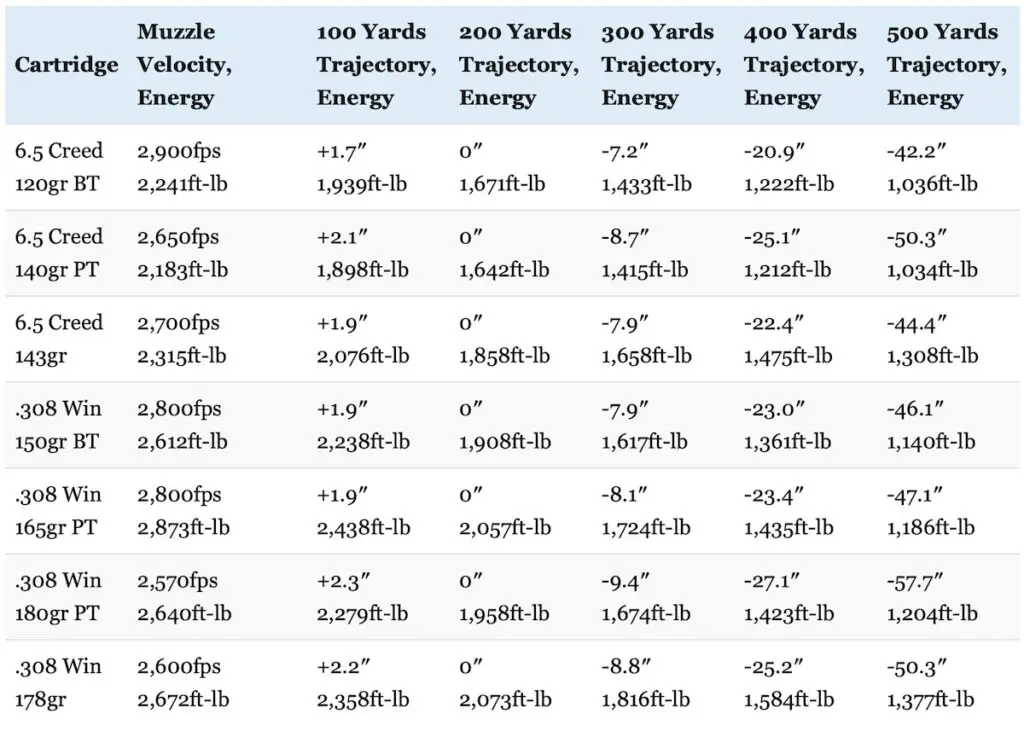
As you can see, the two cartridges have a very similar trajectory out to 300 yards and just 2.2″ separates the flattest shooting load from the one with the most bullet drop. However, the 6.5 Creedmoor has less bullet drop overall, particularly at 400 and 500 yards.
For reference, 180gr Partition has over 15″ more bullet drop than the 120gr Ballistic Tip at 500 yards. That particular 308 load has the most arching trajectory in the group though. If we momentarily discount that 308 load, we see the 178gr ELD-X (which has the 2nd most arching trajectory of the 308 loads) has about 8″ more bullet drop than the 120gr Ballistic Tip.
So yes, the 6.5 Creedmoor is definitely flatter shooting, but we’re not talking about a tremendous difference here and the details do matter quite a bit. Indeed, the 150gr Ballistic Tip and 165gr Partition loads for the 308 are actually a little flatter shooting than the 140gr Partition for the 6.5 Creedmoor (which has the most rainbow like trajectory for that cartridge).
On the other hand, the 308 Winchester has more kinetic energy than the comparable 6.5 Creedmoor loading out as far as we go in this particular comparison.
And every single 308 Winchester load actually has more muzzle energy than every single 6.5 Creedmoor load used in this comparison too.
The situation changes as the range increases and the higher BC 6.5 Creedmoor loads start to catch up to their comparable 308 Winchester loads in the kinetic energy department.
The various .308 Winchester loads start off with 13-32% more muzzle energy than the 6.5 Creedmoor loads. That gap narrows as the bullets travel downrange because the ballistically superior 6.5mm bullets do a better job retaining energy.
The 143gr ELD-X actually passes the 150gr Ballistic Tip just shy of 300 yards, the 165gr and 180gr Partition just shy of 400 yards, and is nipping right on the heels of the 178gr ELD-X at 500 yards!
The details are important to note here.
All things considered, both cartridges are still performing well in this department and every single load for both cartridges carries over 1,500 ft-lbs of kinetic energy out past 200 yards and over 1,000 ft-lbs of kinetic energy out at 500 yards.
Here’s how each 308 Winchester load compares individually to the 6.5 Creedmoor load using the same bullet in terms of muzzle energy, retained energy at 500 yards, and bullet drop at 500 yards:
Nosler Ballistic Tip: the 150gr Ballistic Tip from the 308 has 16.5% more muzzle energy, 10% more kinetic energy at 500 yards, and 3.9″ (9%) more bullet drop at 500 yards than the 120gr Ballistic Tip from the 6.5 Creedmoor.
Nosler Partition: the 165gr 308 Winchester load has 31.6% more muzzle energy, 14.7% more retained energy at 500 yards, and 3.3″ (6.4%) LESS drop at 500 yards than the 140gr Partition from the 6.5 Creedmoor.
The 180gr Partition 308 Winchester load has 21% more muzzle energy, 16.4% more retained energy at 500 yards, and 7.4″ (14.7%) MORE bullet drop than the 140gr Partition from the 6.5 Creedmoor at 500 yards.
Hornady ELD-X: the 308 178gr ELD-X load has 15.4% more muzzle energy, 5.3% more kinetic energy at 500 yards, and 5.9″ (13.2%) more bullet drop at 500 yards than the 143gr ELD-X from the 6.5 Creedmoor.
So, the big takeaways to this point are that the 6.5 Creedmoor is generally a flatter shooting cartridge while the 308 is a harder hitting cartridge, especially at closer range. Yes, there are exceptions, but both of those statements are generally true most of the time.
The chart below compares how much a 10 mile per hour crosswind impacts those same loads out to 500 yards.
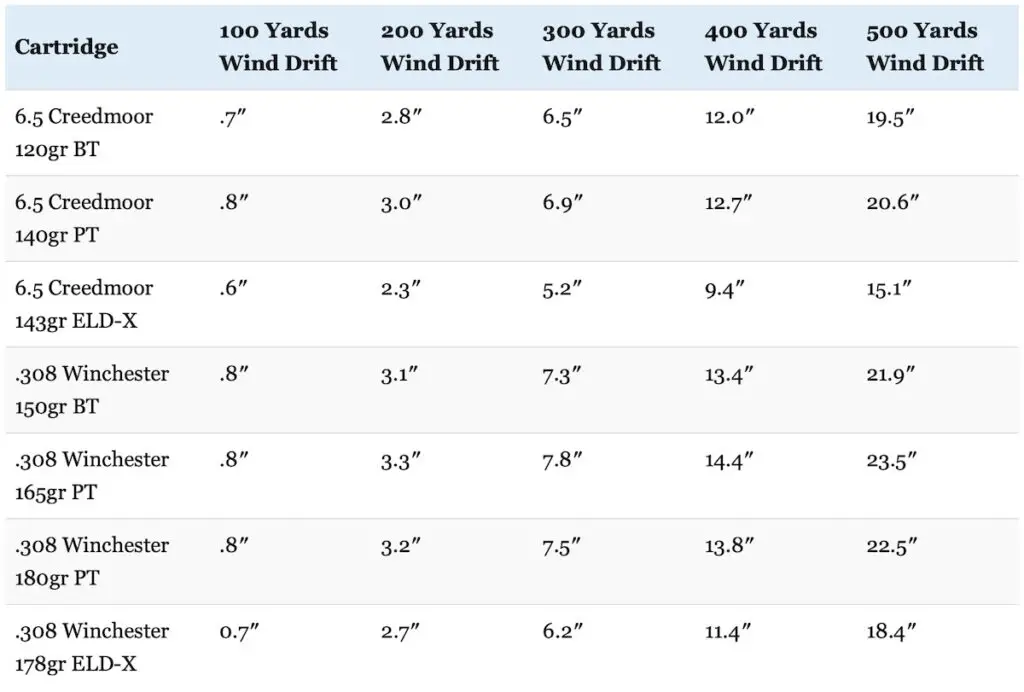
This is where the 6.5 Creedmoor actually starts to stand apart from the 308 Winchester and the superior ballistic coefficient of the 6.5 Creedmoor helps give the cartridge a moderate advantage over the .308 Winchester in terms of wind drift.
Every 6.5 Creedmoor load has less wind deflection than every comparable 308 Winchester load.
The 6.5 Creedmoor ELD-X has the least wind deflection, followed by the 178gr ELD-X, the 6.5 Creedmoor Ballistic Tip load, the 6.5 Creedmoor Partition load, the 150gr Ballistic Tip from the 308, the 180gr Partition from the 308, and finally the 165gr Partition from the 308.
Here’s the breakdown by loading for wind drift at 300 yards and 500 yards:
Ballistic Tip: the 308 has .8″ (12.3%) more wind deflection at 300 yards and 2.4″ (12.3%) more wind deflection at 500 yards.
Partition: the 165gr 308 load has .9″ (13%) more wind deflection at 300 yards and 2.9″ (14.1%) more wind deflection at 500 yards.
The 180gr 308 load has .6″ (8.7%) more wind deflection at 300 yards and 1.9″ (9.2%) more wind deflection at 500 yards.
ELD-X: the 308 has 1.0″ (19.2%) more wind deflection at 300 yards and 3.3″ (21.9%) more wind deflection at 500 yards.
As you can see, this advantage generally grows as the range increases too.
However, the advantage isn’t as pronounced at 500 yards as it is at longer ranges. Since this article is focused on the performance of these two cartridges for hunting, I didn’t include any wind drift figures past 500 yards in the table above.
Just to give you an idea how much the 6.5 Creedmoor advantage in wind drift grows during long range target shooting though, the 6.5 Creedmoor ELD-X load drifts 70.1″ at 1,000 yards. This is nearly 1.5 feet less than the 87.4″ of wind drift for the .308 Winchester ELD-X at the same range.
Additionally, though the .308 Winchester is a relatively mild recoiling cartridge itself (especially compared to other .30 caliber cartridges like the .30-06 and .300 Win Mag), the 6.5 Creedmoor has a big advantage in this area as well.
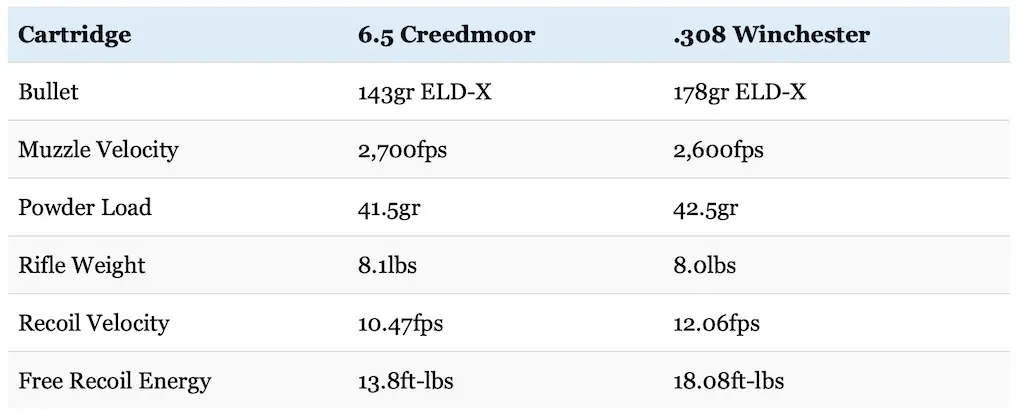
For example, when fired from a Ruger Hawkeye Predator rifle, the 178gr ELD-X from the .308 Winchester has about 30% more recoil than the 143gr ELD-X 6.5 Creedmoor load.
Neither cartridge has bad recoil (less than 20 ft-lbs of free recoil energy with an 8 pound rifle isn’t bad at all), but the 6.5 Creedmoor has a pretty significant edge in this respect.
Don’t underestimate the impact that recoil has on the ability of a person to shoot accurately either. Regardless of how well a given person handles recoil, all other things being equal, they will absolutely shoot better with a milder recoil.
This is an advantage all the time, but is especially important when shooting potentially hundreds of rounds in a single day at the range during a match, in the hands of a small or just recoil shy hunter, or when using a very lightweight rifle.
Like I said: Emary and the rest of the guys at Hornady were successful in building a new cartridge in the 6.5 Creedmoor that was flatter shooting, had less wind deflection, and had less recoil than the 308 Winchester.
Additionally, there are a couple of other factors that are also worth discussing.
The 6.5 Creedmoor also has an advantage when it comes to bullet selection. Since it was originally built for competition shooting, the cartridge was specifically designed to use the longest and heaviest 6.5mm (.264″) bullets available. This is why most 6.5 Creedmoor rifles have a fast 1:8″ rifling twist rate. The cartridge most often utilizes bullet weights in the 95-160 grain range, with 120, 129, 140, and 143gr bullets being the most common.
As we covered earlier, those longer and heavier .264″ bullets have a higher ballistic coefficient than the most common bullets used in the .308 Winchester. They also have a higher sectional density (SD).
Sectional density (SD) is a measure of the ratio of the diameter of a projectile to its mass. All other things equal, a heavier projectile of a given caliber will be longer and therefore have a higher sectional density and consequently penetrate deeper than projectiles with a lower mass and sectional density.
For instance, it’s very uncommon to find .308 loads using bullets heavier than 180 grains.
A 180 grain .308″ bullet has a sectional density of .271 and a 168 grain .308″ bullet only has a sectional density of .253. However, a .264″ 140 grain bullet has a sectional density of .287 and a 143 grain .264″ bullet has a sectional density of .293, which compares favorably to the most common .308″ bullets.
That being said, the .308 Winchester uses larger diameter bullets and consequently has about 36% more frontal surface area (also known as cross sectional area) than the 6.5 Creedmoor (.0745 vs .0547 square inches). All other things being equal, a bigger bullet will make a bigger hole, cause more tissue damage, and result in more blood loss.
6.5 Creedmoor vs .308 Winchester Accuracy
Both cartridges have a long and distinguished history in the competition shooting realm and both cartridges are extremely accurate (offering sub-MOA performance) in the right hands at typical hunting ranges.
However, the 6.5 Creedmoor undeniably has an advantage in terms of accuracy as well.
This is for several reasons, but the fact that the 6.5 Creedmoor uses a much more modern overall cartridge design than the 308 Winchester is an important factor here.
Check out John Snow’s article on this subject at Outdoor Life for more details, but long story short, companies designing new cartridges these days typically employ more modern cartridge design principles that incorporate best practices obtained from competition and benchrest shooters to obtain the best possible accuracy.
Cartridges designed using these principles use faster twist rates to stabilize heavy, high BC bullets, have cases with a long enough neck to support those longer, high BC bullets, can seat those long, high BC bullets to the SAAMI specified maximum overall length without intruding into the powder column, employ minimal body taper, headspace off sharp shoulders, and have a chamber design with a snug throat.
Taken together, these design principles result in cartridges with a very high degree of accuracy potential, especially at extended range.
Like I mentioned earlier, the 6.5 Creedmoor design incorporates all of those principles and this likely explains why the cartridge has such an excellent reputation for accuracy.
Let’s drill down into the chamber design aspect of things in more detail.
The throat is the smooth portion of a rifle barrel closest to the cartridge. Having a more snug throat diameter means there’s less room for the bullet to yaw upon firing before engaging the rifling, which can help enhance accuracy.
Well, the 6.5 Creedmoor has a throat diameter just .0005″ larger than the bullet diameter. This is a significant improvement over the .308 Winchester (.002″).
Additionally, the 6.5 Creedmoor also has a steeper 30 degree shoulder (compared to the 20 degree shoulder of the 308 Winchester) in order to facilitate more precise and consistent headspacing and to minimize Principle Axis Tilt between the projectile and the bore.
In plain English that means the bullet is more precisely aligned with the bore. Contrast that with an image in your mind of a projectile that’s chambered at an angle slightly off center and you can see how a bullet with zero Principle Axis Tilt improves accuracy potential.
The cartridge also has a faster SAAMI spec rifling twist and has a long enough case neck and has ample head height to use those long, heavy, high BC bullets I keep talking about.
Taken together, all of these factors result in better accuracy potential for the 6.5 Creedmoor, especially with long, heavy, high BC bullets.
In fact, the 6.5 Creedmoor has an almost magical reputation for accuracy these days that few other cartridges can match. Heck, even the harshest critics of the 6.5 Creedmoor almost always concede this point.
Until the release of the 6.5 Creedmoor, it was almost unheard of for a person to purchase an off the shelf rifle for $400-500, mount similar priced scope on it, and be able to consistently bang steel all the way out at 1,000 yards using factory ammo.
Hitting a target at 1,000 yards is still no easy feat, but performance like that almost always required a custom rifle, a high end scope, and meticulously handloaded ammunition back as recently as the 1980s or 1990s.
Now a person can do it using a Ruger American Predator in 6.5 Creedmoor with a Vortex scope and Hornady Precision Hunter ammo.
That’s not to say that all 6.5 Creedmoor rifles are accurate with all types of ammunition.
I’m also not saying the 308 Winchester isn’t capable of excellent accuracy at times either.
The exact details will vary on the exact rifle, ammunition, and shooter in question.
However, I will say the 6.5 Creedmoor has the best potential for accuracy of the two cartridges on average using factory rifles and ammunition.
Plus, since it was specifically designed as a competition shooting cartridge and utilizes .264″ bullets, there is a bigger selection of high BC and high SD match grade hunting bullets available for the cartridge.
That’s not to say that the .308 Winchester isn’t accurate or that there aren’t a bunch of good quality bullets available for it. It’s just that the overall design of the 6.5 Creedmoor gives that cartridge an edge over the .308 Winchester.
The United States Special Operations Command (USSOCOM) conducted a study comparing the 6.5 Creedmoor, .260 Remington, and .308 Winchester cartridges a few years ago and they came to a similar conclusion.
Compared to the current M118 Special Ball Long Range .308 Winchester load (a 175gr Sierra MatchKing Boattail Hollow Point) currently used by special operations snipers, the 6.5 Creedmoor had less recoil, doubled hit probability at 1,000 meters, had a 33% longer effective range, retained 30% more energy at 1,000 meters, and had 40% less wind drift at 1,000 meters.
Add it all up and the 6.5 Creedmoor is a clear winner in the accuracy department.
So where do we stand overall with both cartridges?
6.5 Creedmoor vs .308 Winchester
The 6.5 Creedmoor shoots smaller diameter and generally more aerodynamic bullets than the .308 Winchester. Therefore, the 6.5 Creedmoor has a slightly flatter trajectory, a little less wind drift, and less recoil. However, the .308 has a lot more frontal surface area and carries more energy downrange.
With a flatter trajectory and less wind drift, the 6.5 Creedmoor does have a definite, though not gigantic, advantage over the .308 Winchester in external ballistics at typical hunting ranges. This makes the cartridge more forgiving of range or wind estimation errors than the .308 Winchester. It also has less recoil than the .308 Winchester as well as a large selection of high BC match grade hunting bullets.
All things considered, the 6.5 Creedmoor is a cartridge that helps maximize the shooting abilities and maximum effective range of the hunter to a greater extent than the .308 Winchester. Proper shot placement is extremely important when it comes to ethically taking game and the aforementioned strengths of the 6.5 Creedmoor all facilitate precise shot placement. Finally, the high SD bullets used by the 6.5 Creedmoor also assist with penetration to help the cartridge “punch above its weight” in a manner similar to the 7x57mm or 9.3x62mm Mauser cartridges.
On the other hand, the .308 carries more energy downrange than the Creedmoor and has a big advantage when it comes to frontal surface area. Those traits give hunters a tiny bit more room for error in shot placement when compared to the 6.5 Creedmoor.
It might seem like I’m splitting hairs here when talking about the strengths and weaknesses of the two cartridges. That’s absolutely true to a certain degree.
While they certainly have different advantages, both cartridges are very accurate, relatively flat shooting, and hit hard enough for use on a variety of game out to several hundred yards. Regardless of whether you’re using a 6.5 Creedmoor or a .308 Winchester, no pronghorn, deer, or elk will go far if you put a well constructed bullet into the vitals.
308 vs 6.5 Creedmoor Barrel Life
While the two cartridges have a very similar case capacity, throat erosion occurs faster with the 6.5 Creedmoor because it uses a smaller diameter barrel. Simply put, burning the same amount of powder in a smaller space will result in shorter barrel life.
This means that, in general, the 6.5 Creedmoor will simply wear out barrels faster than the .308 Winchester will. Exactly how fast that occurs depends on a number of factors like the quality of the barrel, the exact ammunition used, etc.
For serious target shooters, this is a concern. However, the good news for hunters is that typical 6.5 Creedmoor barrel life of 2,000-3,000 rounds is more than enough to last for many, many years of hunting with no issues at all.
So, there is basically no practical difference in 6.5 Creedmoor vs 308 Winchester barrel life as far as most hunters are concerned.
6.5 Creedmoor vs 308: Ammunition Selection
The .308 Winchester has long ranked among the most popular centerfire rifle cartridges in the United States and elsewhere in the world. It remains extremely popular, but the the 6.5 Creedmoor has steadily grown in popularity over the past decade to give the old 308 a run for its money.
Indeed, the 6.5 Creedmoor is now the most popular chambering in new rifles from many companies and this is reflected in ammunition demand. A barometer I personally like to use for judging whether a cartridge has truly achieved mainstream acceptance is whether or not it’s available in plain Jane hunting ammo like the Federal Power Shok, Remington Core Lokt, and Winchester Power Point lines.
Well, the 6.5 Creedmoor crossed that threshold several years ago (and the 308 did many decades ago).
The 308 Winchester still comes out on top in terms of ammunition availability, but the 6.5 Creedmoor is rapidly catching up.
For example, Sportsman’s Warehouse currently lists 183 308 Winchester loads and 115 6.5 Creedmoor loads as I type this.
The big ammunition manufacturers like Barnes, Berger, Black Hills, Federal Premium, Hornady, HSM, Norma, Nosler, PPU Remington, Sellier & Bellot, Swift, and Winchester all produce a number of high quality 6.5 Creedmoor, and .308 Win factory ammunition suitable for hunting.
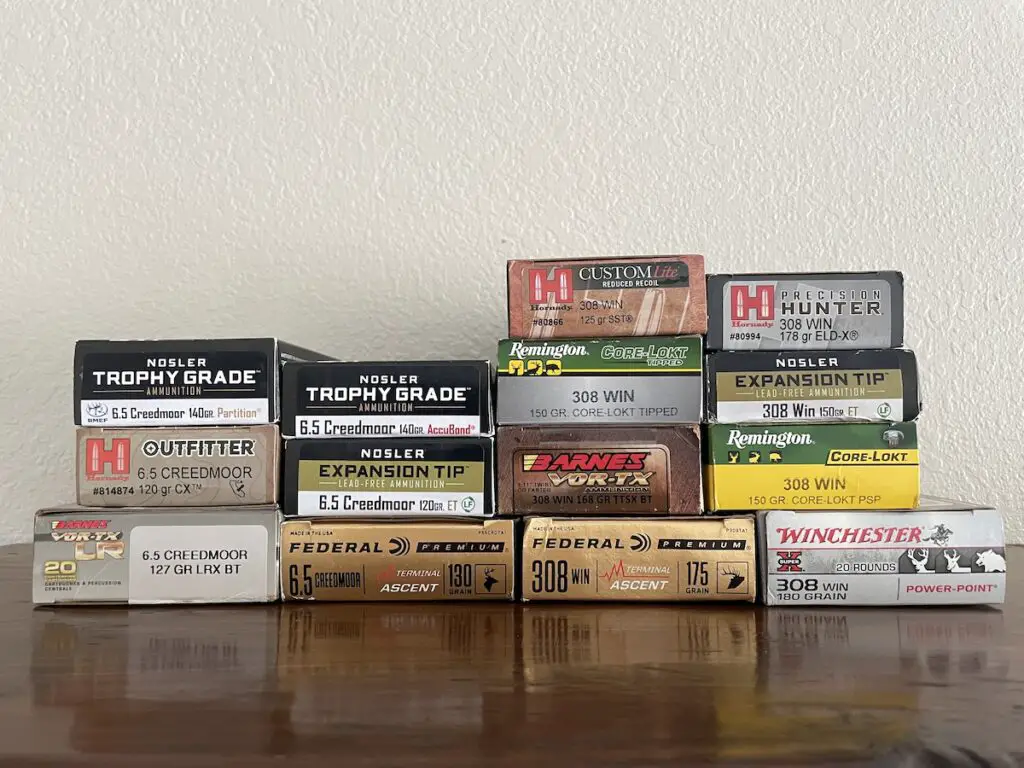
Most of the major bullet styles designed for hunting are available in those cartridges as well like the Barnes TTSX, the Berger VLD, the Hornady ELD-X, GMX, InterLock, SST, and V Max, the Nosler AccuBond, Ballistic Tip, E-Tip, and Partition, the Remington Core Lokt, and the Winchester Power Point.
There’s also a gigantic selection of target shooting bullets for both cartridges as well including (but not limited to) the Hornady A-Max and Sierra MatchKing. Heck, it’s even possible to get varmint hunting bullets for both cartridges.
Prices and availability vary from region to region, but ammunition for both cartridges is very common. The .308 Winchester is a little easier to find than the 6.5 Creedmoor though.
In fact, the 308 Winchester was literally the only high powered centerfire rifle cartridge I never had problems finding hunting ammo for during even the worst points of the 2020-2023 ammo shortage.
Though it was among the first cartridges to come back on shelves (with the 270 and 30-06) and availability has continued to improve, it was tough to find 6.5 Creedmoor ammo for a few months during the worst of the shortage.
Bottom line: ammunition variety and availability are generally a little better across the board for the 308 Winchester when compared to the 6.5 Creedmoor.
Additionally, there is also still a large quantity of full metal jacket military surplus ammo in 7.62x51mm NATO out there. This ammunition isn’t as inexpensive or easy to find as it used to be, but there are still good deals to be had if you look hard enough. Surplus FMJ ammo is ideal for practice, but those aren’t great (or legal) hunting rounds in most states though.
Reloading components for all both cartridges are also widely available so making custom handloads isn’t too difficult for either cartridge. .308 Winchester and 6.5 Creedmoor brass are both widely available.
Since the .308 and 6.5 have the same bullet diameter as other popular .30 caliber and 6.5mm cartridges like the 6.5x47mm Lapua, 6.5 PRC, .264 Win Mag, .30-06 Springfield, .300 Win Mag, .300 Remington Ultra Magnum, .300 PRC, and 300 WSM, there are plenty of .264″, and .308″ bullets of various weights and styles to choose from.
BUY SOME GREAT 6.5 CREEDMOOR AMMO HERE
BUY MORE GREAT 6.5 CREEDMOOR AMMO HERE
BUY SOME EXCELLENT 308 WINCHESTER AMMO HERE
If you’d like to learn more about some of the various hunting ammunition choices for the 6.5 Creedmoor and .308 Winchesters, read the articles below:
Best 6.5 Creedmoor Ammo For Hunting Elk, Deer, And Other Big Game
Best 308 Ammo For Hunting Deer, Elk, Hogs, & Other Big Game
6.5 Creedmoor vs 308: Rifle Selection
Along with the massive number of ammunition choices available in these cartridges, there are lots of quality rifles manufactured in 6.5 Creedmoor and .308 Winchester. Just like with ammunition though, .308 rifles are the most common (though 6.5 Creedmoor rifles are also widely used and easy to find).
For example, Guns.com currently lists 826 6.5 Creedmoor rifles and 930 308 Winchester at this instant.
To an even greater degree than most other gun manufacturers, Ruger has really gotten behind the 6.5 Creedmoor and offers their American, FTW Hunter, Hawkeye Long Range Target, Number 1, Precision, and Scout Rifles in both cartridges. Additionally, the Remington Model 700, Browning X-Bolt, Mossberg Patriot, Nosler M48, Savage Avis, Weatherby Vanguard, and the Winchester Model 70 are all bolt-action rifles available in 6.5 Creedmoor and .308 Winchester.
BUY A NICE 6.5 CREEDMOOR RIFLE HERE
BUY A GREAT 308 WINCHESTER RIFLE HERE
Read the article below if you’d like to learn more details about some of the various hunting rifle choices for the 6.5 Creedmoor.
Best 6.5 Creedmoor Rifles For Hunting – Ultimate Guide
The .308 Winchester is also pretty common in semi-automatic sporting rifles like the AR-10 and M1A as well as military surplus rifles like the FN-FAL. The 6.5 Creedmoor is available in the AR-10 platform and Springfield now offers the M1A in 6.5 Creedmoor as well, but there stilt aren’t very many semi-auto rifles available in that cartridge.

Though there are some exceptions, since both are short-action cartridges, rifles of the same model chambered in each cartridge are virtually identical to each other. Depending on the exact model, 20″, 22″ and sometimes even 24″ barrels are very common for both cartridges.
That said, the 308 is a better option for those looking for a more compact and/or shorter barreled hunting rifle.
Every rifle cartridge needs a barrel of a certain length in order to efficiently and effectively burn their powder charge. Using a cartridge in a rifle with too short of a barrel will result in lower and more erratic muzzle velocities.
The details vary depending on several factors like the size of the powder charge, bore diameter, and type of powder used.
In this case, the 308 Winchester and the 6.5 Creedmoor have similar powder capacities, but the 308 has a slightly larger bore diameter. The end result is it is a little better suited for use with a shorter barreled rifle.
You’ll still lose muzzle velocity by using the 308 in a shorter barreled rifle, but just not as much you probably will with the 6.5 Creedmoor.
This is why rifles with 16″ and 18″ barrels are more common with the 308 and why (with just a handful of exceptions) the 6.5 Creedmoor normally uses 20″+ barrel lengths.
Here’s are a couple of examples to illustrate this point.

Ruger currently manufactures their new Ruger American Generation 2 Predator bolt-action rifle both 6.5 Creedmoor and 308 Winchester and both models use a 22″ barrel.
This is a good example of a “standard” barrel length for both rounds and other popular rifles like the Browning X-Bolt Hunter, Ruger American Standard, and Winchester Model 70 Featherweight use that same barrel length for both the 6.5 Creedmoor and 6.5 Creedmoor.
However, Ruger offers their Ruger American Compact in 6.5 Creedmoor with a 20″ barrel and a shorter 18″ barrel for the 308 Winchester. The same is also true with their SFAR rifle which is available with 16.1″ and 20″ barrels in 308, but only 20″ barrels in 6.5 Creedmoor.
Springfield offers their Standard, Scout Squad, and SOCOM variants of the M1A with 22″, 18″, and 16.25″ barrels respectively, but only offers the 6.5 Creedmoor with a longer 22″ barrel.

There are some exceptions though, like Browning’s X-Bolt 2 Speed SPR, which they offer with 18″ barrels for both cartridges.
Bottom line though: the two cartridges are usually available in the same barrel lengths, but the 308 has more shorter barreled options.
6.5 Creedmoor vs 308: Which Is Right For You?
The 6.5 Creedmoor and .308 Winchester are both flat shooting cartridges ideally suited for hunting thin skinned, small to medium sized animals like blacktail deer, mule deer, whitetail deer, fallow deer, or pronghorn.
While they are excellent choices for hunting deer sized game, these cartridges, but particularly the .308 Winchester, are also suitable for bigger game under the right conditions. When using well constructed bullets and with proper shot placement, they will absolutely work for elk and even moose hunting at reasonable ranges. They’re also acceptable choices for hunting many species of African plains game.
Let’s dive into the details here and I’ll share some specific examples to show you what I mean.
Do you primarily hunt medium sized game like deer, feral hogs, or black bear at ranges within 200 yards? Sure, the 6.5 Creedmoor is a little flatter shooting and drifts a little less in the wind. However, both cartridges will absolutely get the job done if you do your part and there isn’t much of a practical difference between them ballistically inside of 300 yards.
Go with the .308 Winchester if you want the cheapest or easiest to find deer hunting ammo. That cartridge is also generally a little more powerful up close too.
Though I give the nod to the 308 Winchester here, this is not to say the 6.5 Creedmoor is a poor choice for hunting game like deer, hogs, or bear at closer range. On the contrary, it performs really well in this role too. Heck, I even took my largest ever feral hog (which tipped the scales at an honest to goodness 250+ pounds) at about 30 yards with the Creedmoor.
Are you interested in the better cartridge for hunting game like mule deer or pronghorn in open country where you might need to take a shot at several hundred yards?
Dialing for elevation is a much simpler proposition these days of laser rangefinders, custom elevation turrets, and easy to use ballistic apps than was the case even 10 years ago. However, dealing with the wind can be a lot more complicated. Hunters often must battle windy conditions out west too, so I place a high value on cartridges that perform well in windy conditions.
With all this in mind, I give the nod to the 6.5 Creedmoor here due to the advantages the cartridge has with a flatter trajectory and especially in the wind deflection department. Plus, it still carries enough energy out to 400-500 yards to cleanly take deer sized game without any issues.
In fact, I think this is the sort of situation ideally tailored for the 6.5 Creedmoor and the high BC bullets it normally uses.
For instance, I took the pronghorn in the photo below with a 6.5 Creedmoor on a very windy morning in Colorado. Despite the windy conditions, I hit exactly where I was aiming and that 143gr ELD-X delivered devastating terminal performance on this buck.
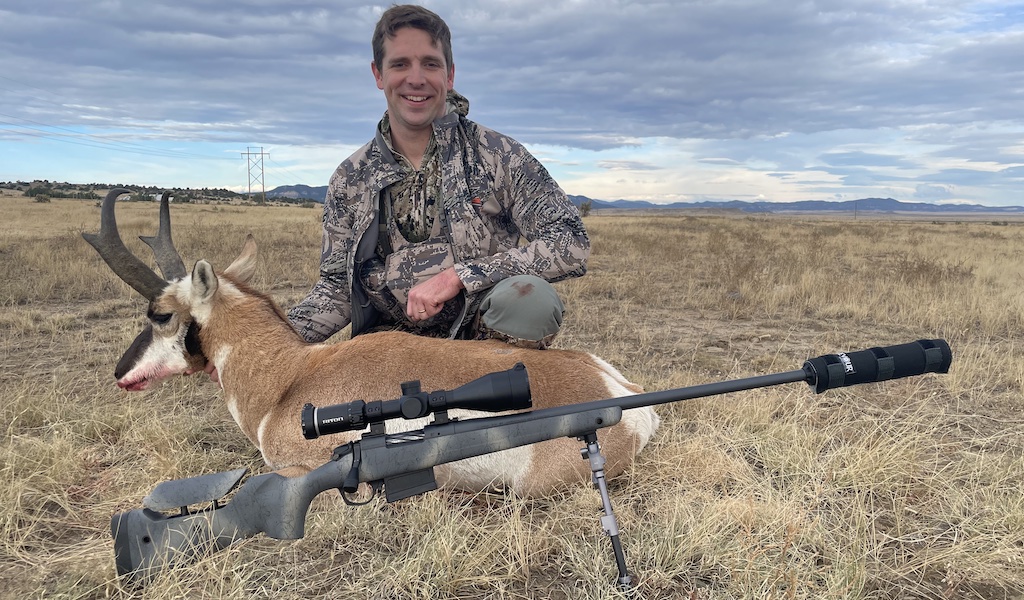
Likewise, the gentleman in the video below experienced similar results on a mule deer with his 6.5 Creedmoor at 248 yards.
In each case, the 6.5 Creedmoor delivered either nearly instantaneous or very rapid incapacitation on those animals with good shot placement.
I don’t mean to throw shade on the .308 Winchester here either. Though I think the 6.5 Creedmoor is a better choice for these situations since it has some advantages that will help hunters battle environmental conditions (especially wind) to place their shots appropriately, the 308 will still work really well.
That said, I’d personally lean strongly towards the 308 Winchester over the 6.5 Creedmoor for hunting bigger game.
Do you want a cartridge well suited for hunting larger game like elk, moose, caribou, or African plains game like kudu, eland, or gemsbok? Especially when using heavier bullets, the .308 Winchester wins hands down here due to the big advantage the cartridge has in in frontal surface area as well as energy at closer range.
Elk are big and tough creatures and the larger frontal diameter and more kinetic energy of the 308 Winchester (at shorter ranges anyway) are definitely helpful when trying to cleanly take a big animal like that.
For instance, Randy Newberg has taken countless elk using the .308 Winchester over the years and is a big proponent of that round for elk hunting.
He tends to do most of his shooting on elk inside 300 yards (and often inside 200 yards) and he always uses premium bullets like the 165gr Nosler Partition. The results speak for themselves and he has a garage full of elk racks, many of which he took with a 308.

While I do prefer the 308 over the 6.5 Creedmoor for bigger game like elk, I’m also not saying the Creedmoor isn’t suitable for elk hunting.
Indeed, don’t let anyone tell you that the 6.5 Creedmoor is too small for moose or elk. Scandinavian hunters have taken untold numbers of moose with the 6.5x55mm Swedish over the past century. That cartridge has ballistics very similar to the 6.5 Creedmoor and is a good example of what a high sectional density bullet will do on really big game animals with excellent shot placement.
For instance, gun writer Wayne van Zwoll took a 6.5 Creedmoor elk hunting in New Mexico right after Hornady introduced the round. As you can see, the cartridge delivered shockingly good performance on that bull out at 600 yards with a 129gr SST bullet.
Does that mean “the 6.5 Creedmoor is a 600 yard elk cartridge”?
Technically, yes.
That doesn’t mean it’s a good idea for you or I to use it like that though.
A lot of things could have gone wrong, but Wayne’s situation was ideal: a calm elk that didn’t know he was there, no wind, a perfectly steady rest, and plenty of time to wait for the ideal shot presentation.
600 yards is a long poke at any animal for most people (myself included), regardless of the cartridge though.
Wayne is also an incredibly experienced shooter and hunter who is far more capable of pulling off a shot like that than the average hunter. In fact, this is definitely something I’d strongly advise most hunters NOT attempt.
I think Mark Floyd’s experience using the 6.5 Creedmoor for elk hunting is a more reasonable example of what the cartridge is capable of.
He took a Ruger American Predator in 6.5 Creedmoor elk hunting in Wyoming in 2019 and cleanly took a nice bull at about 250 yards. The bull was nearly broadside and he shot it in the shoulder with a 143gr ELD-X. The bull staggered, swapped ends, and Mark shot it again through the other shoulder.
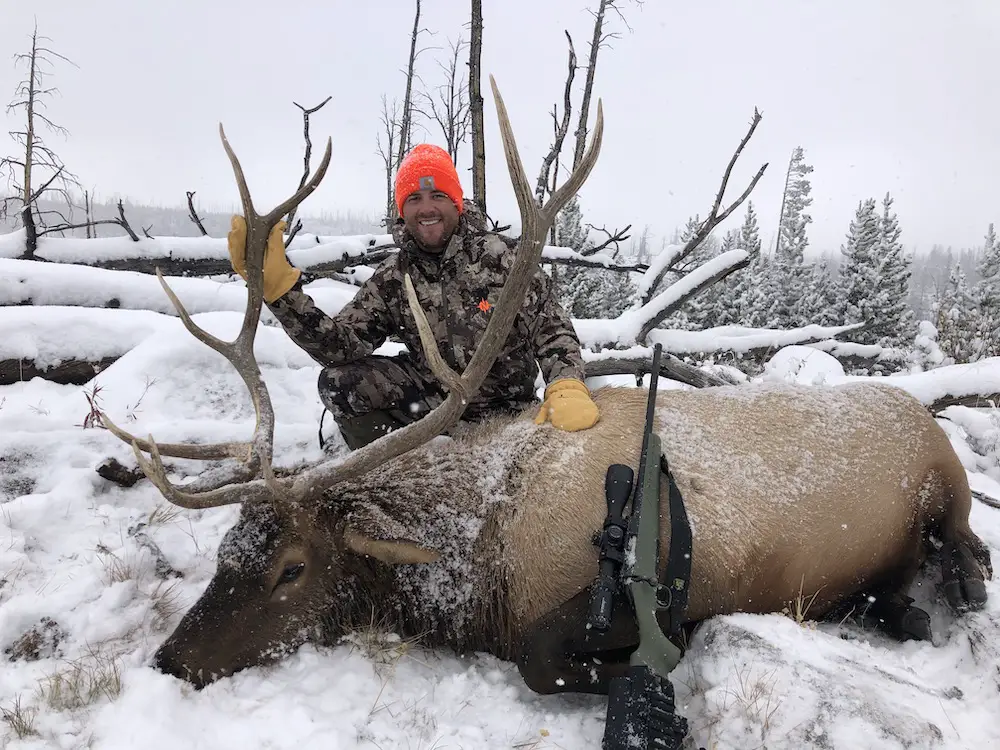
The bull didn’t go too far afterwards after those two hits through the lungs.
So yes, you can hunt elk with the 6.5 Creedmoor. I think it’s far from perfect for that use case and you need to be aware of a couple of things before you go down that road.
Among other things, bullet selection is absolutely critical here and I think something like a 120gr or 127gr Barnes or a 140gr Nosler Partition is perfect for elk hunting with a 6.5 Creedmoor.
There’s more to it than that though, Mark and I recorded an entire podcast episode on elk hunting with the 6.5 Creedmoor. Our discussion does a great job of covering the pros and cons of the 6.5 Creedmoor for elk hunting and anyone planning on going elk hunting in the future should definitely listen to this interview.
Even though both will get the job done, both the 6.5 Creedmoor and .308 Winchester are definitely in a different league from heavy hitting cartridges like the 7mm Rem Mag and .300 Win Mag when it comes to hunting really tough, big, or dangerous game.
For me personally, I prefer to use a more powerful cartridge than either the 6.5 Creedmoor or the .308 Winchester (the 300 Win Mag is my personal favorite) on game bigger than deer.
Are you specifically hunting brown or grizzly bear? What if you do a lot of hunting in Canada or Alaska and need a heavy hitting cartridge just in case you find yourself on the wrong end of a grizzly/brown bear attack?
Between the 308 and the 6.5 Creedmoor, I’d definitely prefer the 308 Winchester with premium 180gr bullets (like a 180gr Nosler Partition) if encounters with bigger bears are a possibility.
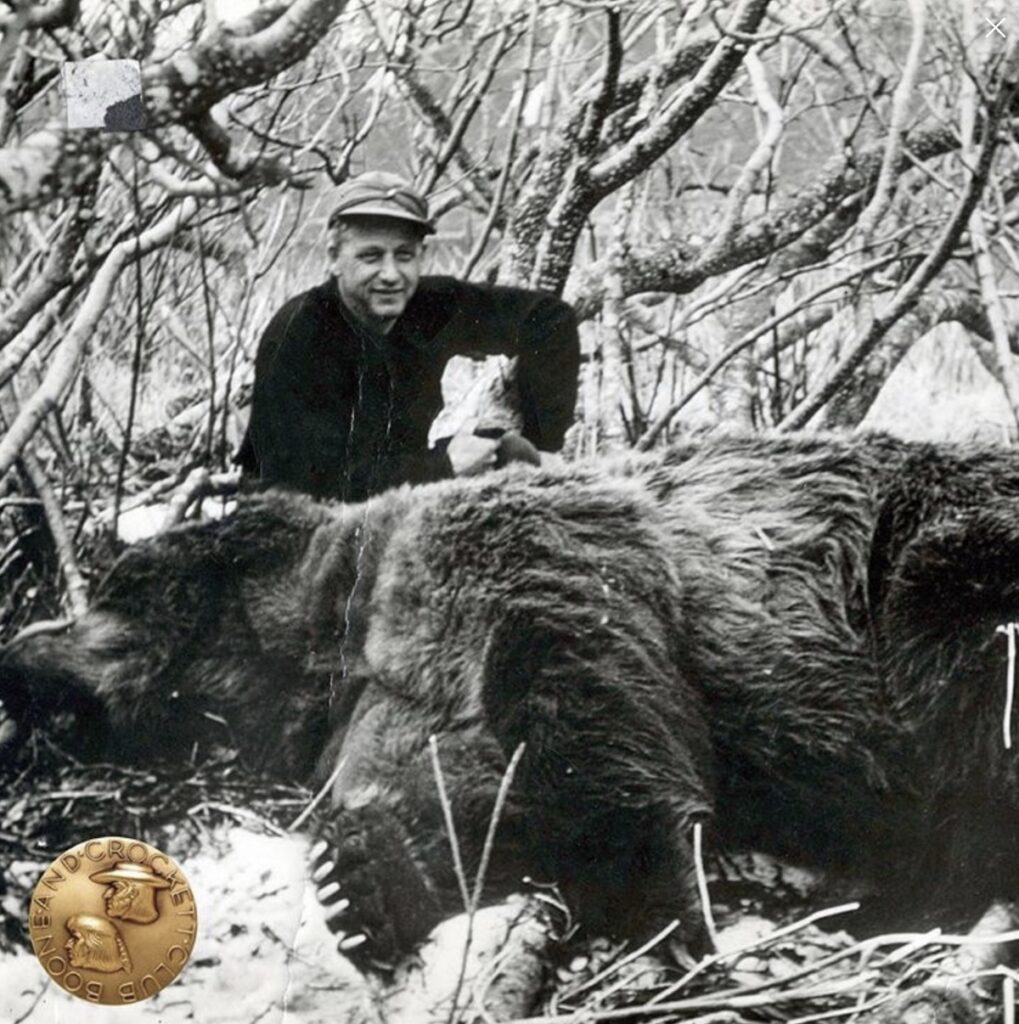
Roy Lindsley actually used a .30-06 Springfield to take the current Boone & Crockett record Alaska brown bear on a hunt on Kodiak Island in 1952. Like I mentioned earlier, modern 308 Winchester ammo isn’t that much different from 30-06 ammunition at the time, so Mr Lindsley killed that bear with a load that roughly approximated the 308 factory loads in common use today.
Additionally, hunters these days have access to much better quality ammunition and bullets than was the case back in the 1950s, which can make these cartridges more effective on creatures like that than used to be the case.
To that end, Outdoor Life writer Tyler Freel took a heck of a grizzly bear in Alaska in 2023 with his 6.5 Creedmoor. He was hunting over bait and ambushed that bear at close range, but the Creedmoor still killed that bear about as quickly and cleanly as identical shot placement from something like a 338 Win Mag or a 375 H&H.

As you can see in the video below, that bear didn’t even make it out of the video frame after three 140gr Nosler Partitions went through his lungs (two even completely exited the bear).
So while I wouldn’t say the 6.5 Creedmoor is an ideal grizzly bear hunting cartridge (and neither would Tyler) it will darn sure work in a pinch and this is a great example of the adage “a smaller bullet in the right place is more effective than a larger bullet in the wrong place.”
Just keep this example in mind the next time someone starts trashing the 6.5 Creedmoor as being too light for hunting.
But to be perfectly frank, I do not recommend using the 308 or the 6.5 Creedmoor for actually hunting the big bears (the same is true for other species of dangerous game like cape buffalo) and I’d prefer to carry something much more powerful in grizzly country instead.
I only give those examples of Mr van Zwoll’s elk along with Mr. Freel’s and Mr. Lindsley’s bears to illustrate what those cartridges are capable of in the right hands.
With results like that on really big bears and on elk at that range, you should have plenty of confidence in both the 308 and the 6.5 Creedmoor to cleanly kill smaller animals like deer and black bear, especially at shorter ranges.
Are you sensitive to recoil? Go with the 6.5 Creedmoor. This cartridge is especially well suited to new, small framed, and or recoil shy hunters. There are certainly more lower recoiling options for the 6.5 Creedmoor, but the 308 Winchester can deliver surprisingly mild recoil with special light recoiling handloads or certain factory loads (like the Hornady Custom Lite line).
For instance, I took my first deer as a kid with a .308 Winchester using special, light recoiling handloads my dad cooked up for me. Recoil was very manageable, even for my skinny frame at the time and this whitetail buck didn’t go very far after I slipped one of those 130gr Sierras through his ribs.
Do you want to use a semi-automatic rifle for hunting or want a battle rifle for personal defense? Go with the .308 Winchester as there are many more quality rifles available in this cartridge than the 6.5 Creedmoor.
Are you a serious long range shooter searching for the cartridge best suited for long-range target shooting out to 1,200 yds or so in a precision rifle? Again, go with the 6.5 Creedmoor, which really stands head and shoulders above the .308 Winchester for long range precision shooting.
Like I’ve said many times before, the 6.5 Creedmoor and the .308 Winchester are both excellent rifle cartridges. While the differences between them (6.5 Creedmoor vs 308 Winchester) are pretty big in some areas, one isn’t really “better” than the other on the whole.
Both the 6.5 Creedmoor and the .308 Winchester are excellent all-around hunting cartridges for pursuing most species of big game when used at reasonable range, with quality ammunition, and with good shot placement.
Those that prioritize larger caliber and heavier bullets should go with the 308 Winchester. Hunters who want a more efficient, sweeter shooting, and milder recoiling cartridge should opt for the 6.5 Creedmoor.
Or you can just be like me and have rifles chambered in each one!
Are you just itching to take a rifle chambered in one of these cartridges on a hunt?
Book an incredible black bear hunt here.
Book a great African safari hunt here.
If you’d like to learn more about how the 6.5 Creedmoor stacks up to a few other popular hunting cartridges, read the articles below.
260 Remington vs 6.5 Creedmoor vs 6.5×55 Swede
6.5 Grendel vs 6.5 Creedmoor: Which 6.5 Is Right For You?
25-06 vs 6.5 Creedmoor vs 270 Winchester: The Results Might Surprise You
6.5 Creedmoor vs 300 Win Mag Review And Comparison
6.5 Creedmoor vs 308 Winchester Frequently Asked Questions
Is a 6.5 Creedmoor more powerful than a 308?
Generally no. The details vary depending on the specific loads compared, but most 308 Winchester factory loads have more muzzle energy than most 6.5 Creedmoor factory loads. However, the 6.5 Creedmoor often uses more aerodynamic bullets that retain energy and velocity really well and will eventually surpass the 308 in retained kinetic energy as ranges increase.
What caliber is 6.5 Creedmoor equal to?
The 6.5 Creedmoor shoots .264″ caliber bullets.
What is the 6.5 Creedmoor best for?
The 6.5 Creedmoor is an outstanding cartridge for hunting deer sized game in North America, Europe, and Africa, especially in more open and/or windy country where the cartridge’s outstanding accuracy potential, relatively flat trajectory, and really good resistance to wind drift really start to set it apart from the competition.
Enjoy this article about the 6.5 Creedmoor vs 308 Winchester debate? Please share it with your friends on Facebook and Twitter.
Nosler provided the data used to compare the recoil of the 6.5 Creedmoor vs 308 cartridges (here and here). The Lyman 50th Edition (183-184 & 241-245), and Hornady 10th Edition (317-322 & 474-484) reloading manuals were also used as references for the history of the cartridges and provided data to compare their size. Ballistic data for original 7.62x51mm cartridge was obtained from Inetres and SAAMI specifications for the 308, 30 TC, and 6.5 Creedmoor were obtained here. Chuck Hawks provided case capacity data for the cartridges (here and here). The data used to compare the trajectory of the cartridges was obtained from Nosler (here and here) and Hornady (here and here). I used the Hornady Ballistic calculator and Shooters Calculator to compare wind drift and recoil for the cartridges.
Make sure you follow The Big Game Hunting Blog on Facebook, Instagram, Twitter, and YouTube.
NEXT: 223/5.56 vs 300 BLACKOUT vs 308 WINCHESTER: WHICH IS BEST?
NEXT: 224 VALKYRIE: SHOULD YOU BUY ONE?
NEXT: BEST HUNTING EAR PROTECTION FOR SPORTSMEN
John McAdams is a proficient blogger, experienced shooter, and long time hunter who has pursued big game in 8 different countries on 3 separate continents. John graduated from the United States Military Academy at West Point and is a veteran of combat tours with the US Army in Iraq & Afghanistan. In addition to founding and writing for The Big Game Hunting Blog, John has written for outdoor publications like Bear Hunting Magazine, The Texas State Rifle Association newsletter, Texas Wildlife Magazine, & Wide Open Spaces. Learn more about John here, read some of John’s most popular articles, and be sure to subscribe to his show: the Big Game Hunting Podcast.


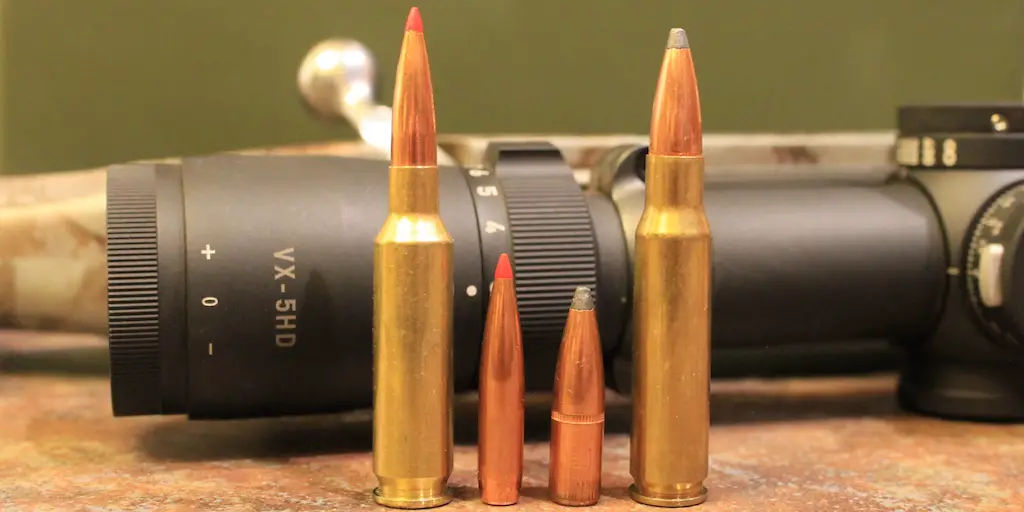
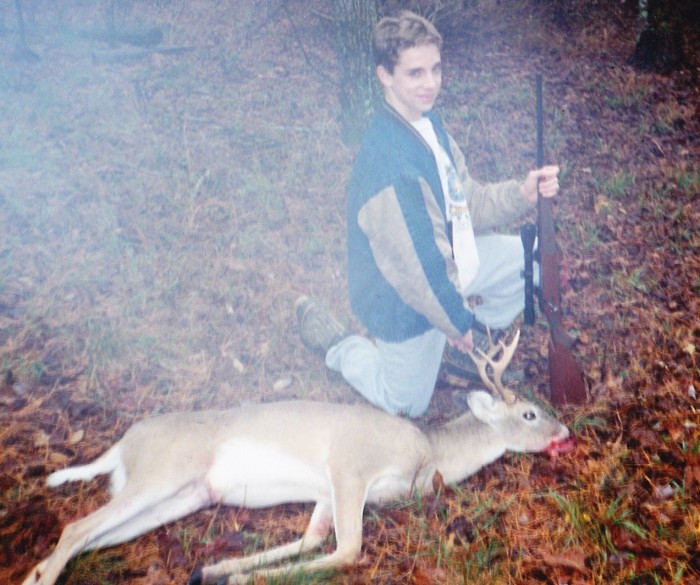
This is fun.
The 6.5 Creedmoor has rendered both itself and the 308 as sub-par (not obsolete mind you).
For decades the 308 held some regard because though it lacked the knock-down power of the 30-06 at closer ranges, it was (generally speaking) more accurate.
Now we have the new champion, the 6.5 Creedmoor, that is more accurate at longer ranges than the 308. Alas 6.5 Creedmoor delivers far less knock down power to be considered a replacement for the 30-06 for larger game (or the 308 for that matter) depending on the range.
I’m not sure why a comparison between the two was in order … or why there was a “so-called” debate in the first place.
The 6.5 Creedmoor is a flat-shooting round.
The 308 is a harder hitting round at closer ranges.
There are a number of rounds on each end of the caliber spectrum that outperform both of them.
So what.
The 338 Lapua Magnum outperforms most everything.
If ya want a good long range rifle chaos the 338 Lapua.
Tell me you didn’t read the article without saying you didn’t read the article…
The difference is so miniscule that anyone arguing over this is just a moron. And apparently the writer has no idea what muzzle energy is. Because apparently it means something different to the rest of us.
The .308 Winchester does start off with a big advantage in kinetic energy of 345 and 357 foot pounds of energy at the muzzle
345 ft lbs at the muzzle? Did he copy and paste a 9mm?
Thank you very much for your very kind & thoughtful comment Charles. When I say the 308 Winchester has a “big advantage in kinetic energy of 345 and 357 foot pounds of energy at the muzzle with the E-Tip and ELD-X”, most people would take that to mean that the 308 has 345 and 357 foot pounds MORE energy than the 6.5 Creedmoor with those two specific bullets. You could say that’s a “minuscule” difference if you’d like, but others would say a ~15% advantage in favor of the 308 is more significant.
There’s a difference in shooting a .338 Lapua Magnum which most people don’t consider, cost and physical abuse. I shot a Sako TRG-42 in competition for years and one thing was certain, it may be a powerhouse, but, if you don’t shoot it often you won’t be any good with it. Barrel life on average was anywhere between 750 and 950 rounds, dependent on bullet weight and type of powder being used. In three shooting seasons I consumed five barrels and several thousands of dollars in ammunition which I reloaded myself. If you hunt with a .338 Lapua Mag you are usually just a one shot wonder. I know very few hunters that can actually “use” a .338 Lapua Mag to the potential it’s ballistics offer. Can that elk be downed with a 30-06, sure, but why use a 30-06 when you can take field artillery with you and brag about shooting an elk with a .338 Lapua Magnum. Did I ever hunt with a .338 Lapua, sure I did, killed an elk at over 1500 yards with it. Why did I take that shot, because I could, knew the ballistics and the gun, and knew what to expect when the loud pedal was pressed. Now, would I take a .338 Lapua with me now to hunt, nope, been off the gun and cartridge too long and therein lies the problem. You don’t use it, you loose it. That sucker burns anywhere between 89 and 95 grains of powder pushing a 300 grain Sierra MatchKing, not even a little pleasant. But you know what, took a 6.5 Creedy with me last year and dropped an elk like it was pole axed at about 470 yards with an ear shot. Only difference was I wasn’t suffering from concussion induced mental trauma and my synthetic shoulder complained not one bit. Yes, we can all balls up on a caliber to hunt whatever it is you think you need to vaporize with a .338 Lapua Mag, but sometimes it’s not about quantity and it’s just about the quality. For me, the monster magnums are behind me. I kinda like the 6.5 Creedy, easy to shoot, easy to load for, and laser beam accurate. Give it a try and you just might like it!
1500 yard elk shot, only a fool would believe that. The 6.5 Ceedmor is a good cartridge but at REALISTIC hunting yardage, say up to 300 yards,
The.308 and even better 30/06 deliver much better ballistics.
nowhere did he say he took an elk at 1500 with a 6.5cm.
308 150 grn psp at 2,820 fps
6.5 143 grn at 2,730 fps
260 rem 143 grn at 2,730 fps
None of the above are a laser
Only the 308 can utilize a 180 or 210 grn bullet. For clean harvest.
And NO ONE ever compared the 260 rem to a 308.
Marketing sells I guess.
History is hitting the rinse/spin/repeat cycle.
The 308 was designed to replace the 30-06 but failed to do so. While the 308 mimics the overall performance of the 30-06 and is more accurate at longer ranges it lacks the ability the chamber heavy rounds. At the pedestrian ranges most used by both rounds the difference in accuracy is insignificant. Now we have the 6.5 Creedmoor whose story almost duplicates that of the 308 vs 30-06.
While 6.5 provides some incremental improvement in accuracy at longer ranges, the hunting community has already determined the belted magnums (7mm and 300 Win Mag) are better suited for this. So the 6.5 Creedmoor is just another cartridge … although not as ubiquitous as the 308.
I agree that the 6.5 Creedmor is just another cartridge, but the.308 was not really designed to actually replace the 30/06 , but the military wanted a round with similar balistics for a faster firing machine gun, M-60 and the issue weapon M-14.
Scott, If you need to brag about your “big gun” maybe you should not be hunting at all. Joe
great article
Worth adding to this article— a stat that is measurable and significant— barrel length.
Creed requires a longer barrel to get the sought-after ballistics. 308 doesn’t, given that its intended range was shorter, and it wasn’t intended for competitions.
My canned 308 rifle has a shorter OAL, quieter, and softer recoil impulse than most naked creeds with 24” barrels. I’d challenge all of you to compare a canned 308 against a creed for weight, portability in nasty terrain, etc. I think you’ll come to the same conclusion I did. Being able to carry a semi-auto for these ranges instead of a bolt gun is also a significant advantage that I think is undersold here, but I follow why the author went that direction. I assume he wanted to keep apples and apples together.
If you practice with your tool (338/308/6.5cm) you will not only gain knowledge but you will gain confidence. There’s a thing called repeatability and you can only gain that with experience. 6.5 cm shooting 129 sst 300 yard 0 (point blank trajectory). Last 5 years in a row 575-690 yard all one shot ethical kills on big northwest mule deer. I can put that same 129 on a paper plate out to 850 but will not shoot to kill past 700. To each his own but I downgraded to a 6.5 cm and realize now that it was just a trade off in inches. The absolute biggest advantage for me is the low recoil as I can shoot every time and watch bullet impact in my scope. 22” barrel ruger American with magpul hunter stock. Not a custom built something anyone can get for relatively cheap under $1000.00 with good moa turret scope. Practice practice practice know your tool and use it as often as you can